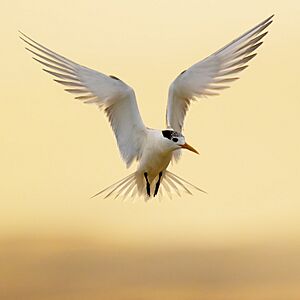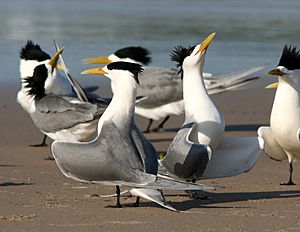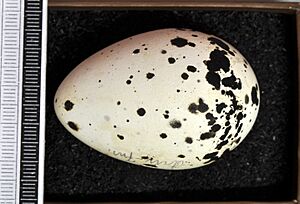Greater crested tern facts for kids
Quick facts for kids Greater crested tern |
|
|---|---|
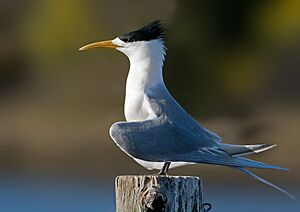 |
|
| Breeding plumage T. b. cristata displaying | |
| Conservation status | |
| Scientific classification | |
| Genus: |
Thalasseus
|
| Species: |
bergii
|
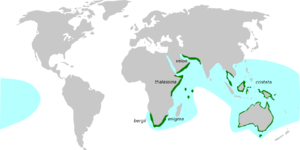 |
|
| Approximate breeding range Wintering range |
|
| Synonyms | |
|
Sterna bergii Lichtenstein, 1823 |
|
The greater crested tern (Thalasseus bergii) is a large seabird. It is also known as the crested tern or swift tern. These birds belong to the tern family, called Laridae. They build their nests close together in large groups called colonies. You can find them on coastlines and islands in warm parts of the world, mostly in the Old World (Africa, Asia, Europe, and Australia).
There are five different types, or subspecies, of the greater crested tern. They live from South Africa all the way around the Indian Ocean to the central Pacific and Australia. After they finish nesting, these birds spread out widely from their breeding areas. The greater crested tern is related to the royal and lesser crested terns. You can tell them apart by their size and the color of their beak.
This tern has grey feathers on its back and white feathers underneath. It has a yellow beak and a shaggy black crest of feathers on its head. This crest becomes less noticeable in winter. Young terns look different, with a mix of grey, brown, and white feathers. They depend on their parents for food for several months after they learn to fly. Like other terns in its group, the greater crested tern dives into the water to catch fish. Males often offer fish to females as part of their courtship.
This bird is very good at adapting to different places. It has learned to follow fishing boats to eat fish that are thrown overboard. It also nests in unusual spots, like on building roofs or on man-made islands in salt pans and sewage works. Other birds like gulls and ibises sometimes eat their eggs and young. Human activities like fishing, hunting, and collecting eggs have caused some local populations to shrink. However, the greater crested tern is not globally endangered. Its total population is stable, with over 500,000 birds.
Contents
What is a Greater Crested Tern?
Terns are small to medium-sized seabirds. They are related to gulls, skimmers, and skuas. Terns look a bit like gulls but are usually lighter. They have long, pointed wings that help them fly fast and gracefully. They also have a deeply forked tail and short legs. Most terns have grey feathers on top and white feathers underneath. They usually have a black cap on their head, which gets smaller or has white spots in winter.
|
||||||||||||||||||||||||
| How Thalasseus Terns are Related |
The greater crested tern was first described in 1823 by a German scientist named Martin Lichtenstein. He called it Sterna bergii. Later, scientists moved it to its current group, Thalasseus. This happened after studies of their DNA showed that different terns with similar head patterns were closely related.
The closest relatives of the greater crested tern are the lesser crested tern (T. bengalensis) and the royal tern (T. maximus). The Chinese crested tern (T. bernsteini) is also likely very closely related.
The name of the tern's group, Thalasseus, comes from the Greek word Thalassa, meaning "sea." The second part of its scientific name, bergii, honors Karl Heinrich Bergius. He was a Prussian pharmacist and botanist who found the first specimens of this tern near Cape Town.
The greater crested tern has about five different types, or geographical races. They mainly differ in the color of their upper feathers and beak. Here are the main types:
| Subspecies | Where it Breeds | Special Features | Number of Birds |
|---|---|---|---|
| T. b. bergii (Lichtenstein, 1823) |
Coasts of South Africa and Namibia | Dark grey on top, a bit larger than thalassina, least white on head | About 20,000 birds (including 6,336 breeding pairs in South Africa and up to 1,682 pairs in Namibia) |
| T. b. enigma (Clancey, 1979) |
Zambezi delta, Mozambique, south to Durban, South Africa | Lightest colored subspecies | 8,000–10,000 birds in Madagascar and Mozambique |
| T. b. cristata (Stephens, 1826) |
Eastern Indian Ocean, Australia and western Pacific Ocean | Like bergii, with tail, rump, and back all the same color. Paler in Australia | Over 500,000 birds in Australia |
| T. b. thalassina (Stresemann, 1914) |
Western Indian Ocean | Small and pale, larger and less pale in the south | 2,550–4,500 birds in Eastern Africa and Seychelles |
| T. b. velox (Cretzschmar, 1827) |
Red Sea, Persian Gulf, northern Indian Ocean | Largest, heaviest, darkest, and longest-billed subspecies | 33,000 in the Middle East (including 4,000 pairs in Oman and 3,500 pairs on islands near Saudi Arabia) |
How to Identify a Greater Crested Tern
The greater crested tern is a big tern. It has a long yellow beak, which is about 5.4 to 6.5 centimeters (2.1 to 2.6 inches) long. Its legs are black, and it has a shiny black crest of feathers on its head that looks shaggy at the back. An adult bird of the most common type, T. b. bergii, is about 46 to 49 centimeters (18 to 19 inches) long. Its wings can spread out to about 125 to 130 centimeters (49 to 51 inches). This type of tern weighs between 325 and 397 grams (11.4 to 14.0 ounces).
Its forehead and belly are white, while its back and inner wings are a dark grey. In winter, the feathers on its back become a lighter grey. The top of its head turns white, blending into a speckled black crest and mask at the back.
Both male and female adult terns look the same. However, young birds look quite different. Their heads look like winter adults, but their upper feathers have strong patterns of grey, brown, and white. Their folded wings seem to have dark stripes. After they shed their old feathers (called moulting), young terns look more like adults. But they still have a varied wing pattern with a dark bar on their inner flight feathers.
The royal tern is similar in size but is built more heavily. It has wider wings, a lighter back, and a blunter, more orange beak. The greater crested tern is often seen with the lesser crested tern. However, the greater crested tern is 25% larger. It also has a longer beak, a bigger head, and a bulkier body. The lesser crested tern has an orange-tinted beak. Its young feathers are much less patterned than those of the greater crested tern.
The greater crested tern is very noisy, especially when it is breeding. Its call to claim its territory is a loud, harsh sound, like a crow, "kerrak." Other sounds include a "korrkorrkorr" when they are anxious or excited at the nest. They also make a hard "wep wep" sound when flying.
Where Greater Crested Terns Live

The greater crested tern lives in warm coastal areas of the Old World. This includes parts of Africa, Asia, and Australia. The types T. b. bergii and T. b. enigma breed in Southern Africa, from Namibia to Tanzania. They might also breed on islands around Madagascar. There are gaps in their breeding areas, with other groups found in Somalia, the Red Sea, and southern India.
These terns breed on many islands in the Indian Ocean, such as Aldabra and Etoile in the Seychelles. They also breed in the Chagos Archipelago and Rodrigues. You can find colonies on many Pacific islands, including Kiribati, Fiji, Tonga, the Society Islands, and the Tuamotus.
Their nests are usually on low, sandy, rocky, or coral islands. Sometimes they are among small shrubs, but often they are in open areas with no shelter. When they are not breeding, greater crested terns rest on open shores. They sometimes rest on boats, piers, harbor buildings, or raised salt mounds in lagoons. They are rarely seen in tidal creeks or inland waters.
After breeding, all greater crested terns spread out. Birds from Southern Africa often move east to the Indian Ocean coast of South Africa. Many young birds also travel east, sometimes over 2,000 kilometers (1,200 miles). Others move north along the western coast. The T. b. thalassina type spends winter on the east African coast, as far north as Kenya and Somalia. It can also move south to Durban. The T. b. velox type, which breeds from the Persian Gulf eastward, tends to stay in one area or spread out, rather than truly migrating. However, those breeding in the Red Sea spend winter south along the east African coast to Kenya. The T. b. cristata type usually stays within 400 kilometers (250 miles) of its colonies. But some birds wander up to about 1,000 kilometers (620 miles). This species has been seen by chance in places like Hawaii, New Zealand, North Korea, Jordan, and Israel.
In India, the Greater crested tern is protected in the PM Sayeed Marine Birds Conservation Reserve.
Greater Crested Tern Life Cycle
Breeding and Raising Young
The greater crested tern nests in large groups called colonies. They often nest alongside other seabirds. These birds are monogamous, meaning they have one partner. Their pair bond lasts all year and sometimes for several breeding seasons. The size of the colony depends on how much fish food is available. The largest known colony, with 13,000 to 15,000 pairs, is in the Gulf of Carpentaria in northern Australia. This area also has many other seabird colonies. Nesting here happens after the summer monsoon floods. This is probably because more fish are available due to nutrients from rivers flowing into the Gulf. These terns do not always nest in the same spot each year. They often change their nest site, sometimes moving more than 200 kilometers (120 miles).

A male greater crested tern chooses a small area in the colony for nesting. At first, he pecks at any other tern that enters his space. If it's another male, it will fight back, and the male tern will usually chase it away. A female entering the nest area acts calmly to the male's pecking. This helps him know she is a female and start the pair-forming process. This involves displays like raising and bowing his head. This behavior is repeated often during nesting to strengthen the bond between the pair. Terns also use fish as part of their courtship. One bird flies around the colony with a fish in its beak, calling loudly. Its partner might also fly, but they eventually land, and the fish is given as a gift.
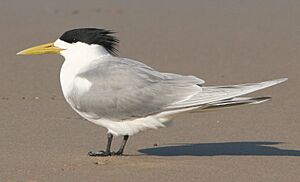
The nest is a shallow dip in the sand on open, flat, or sometimes sloped ground. It often has no lining, but sometimes includes small stones or cuttlefish bones. They lay one, sometimes two, eggs. Both parents sit on the eggs (this is called incubation) for 25 to 30 days until they hatch. The eggs are cream-colored with black streaks. All the eggs in a colony are laid around the same time. Parents do not recognize their own eggs or newly hatched chicks. But they can tell their chicks apart by the time they are two days old, just before the chicks start to wander from the nest. The chicks are born able to move around (they are precocial). They are very pale with black speckles. Both parents keep them warm and feed them. Older chicks may gather in groups called crèches. The young terns learn to fly after 38 to 40 days. However, they still rely on their parents for food after leaving the colony until they are about four months old.
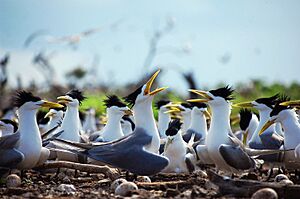
In South Africa, these terns have learned to nest on building roofs. They sometimes do this with Hartlaub's gulls, which also share their usual nesting spots. In 2000, about 7.5% of this type of tern nested on roofs. They have also recently started nesting on man-made islands in salt pans and sewage treatment areas. This shows how adaptable these seabirds are.
Adult terns have few enemies. However, in Namibia, young birds often have their food stolen by kelp gulls. These gulls, along with Hartlaub's gull, silver gull, and sacred ibis, have been seen eating eggs or young chicks. This happens especially when colonies are disturbed. Smaller groups of nests, especially those with more nests on the edges, face more danger from predators. In Australia, cats and dogs sometimes prey on them. There have also been cases of terns dying from being shot or hitting cars, wires, or light towers.
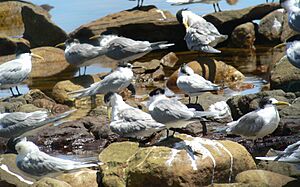
Commercial fishing can affect the greater crested tern in both good and bad ways. Young terns survive better when fishing boats throw away extra fish, giving them more food. Huge increases in their numbers in the southeastern Gulf of Carpentaria are thought to be because of a large prawn fishing industry. On the other hand, purse-seine fishing reduces the amount of food available. Big changes in the number of greater crested terns breeding in South Africa's Western Cape are linked to changes in the amount of fish available. Terns can be killed or hurt by hitting fishing lines, getting caught in nets, or hooked by longline fishing. However, unlike albatrosses and petrels, there is little proof that their overall numbers are greatly affected.
One unusual event happened off Robben Island, South Africa. 103 terns became unable to fly because of marine foam. This foam was created by waves, kelp slime, and tiny ocean plants. After treatment, 90% of the birds were able to be released.
What Greater Crested Terns Eat
Fish are the main food for the greater crested tern. They make up almost 90% of what these birds eat. The rest of their diet includes cephalopods (like squid), crustaceans (like crabs), and insects. They have also been seen eating unusual prey like agamid lizards and baby green turtles.
The greater crested tern mostly hunts at sea by diving into the water. They can dive up to 1 meter (3.3 feet) deep. They also catch food by dipping from the surface. They usually swallow their food while flying. During the breeding season, birds may fly up to 10 kilometers (6.2 miles) from land to find food. The fish they catch range from 7 to 138 millimeters (0.3 to 5.4 inches) long and weigh up to 30 grams (1.1 ounces). They typically eat schooling fish like anchovy and sardine. But they also eat fish that live on the bottom of the ocean, which are often thrown away by commercial fishing boats. This tern actively follows fishing boats, even at night. During fishing season, fish thrown away by trawlers can make up 70% of their diet. Prawn fishing is especially helpful for providing extra food. This is because prawns usually make up only 10–20% of the catch. The rest is bycatch, mostly fish like cardinalfish and gobies.

A study in the Great Barrier Reef found that the number of breeding greater crested terns has increased ten times. This is probably due to extra food from fishing by-catch. The study suggested that lesser crested and sooty terns have moved away. They now breed in a part of the reef where fishing is not allowed. It's possible that the large increase in greater crested terns has affected other species. This could be due to competition for food and nesting spots.
Terns have red oil droplets in the cone cells of their eyes. These droplets help them see better by improving contrast and making distant objects clearer, especially when it's hazy. Birds that need to see through both air and water, like terns and gulls, have more brightly colored carotenoid pigments in these oil drops than other birds. This improved eyesight helps terns find groups of fish. It's not certain if they see the tiny ocean plants that fish eat, or if they watch other terns diving for food. Terns' eyes are not very sensitive to ultraviolet light. This is an adaptation more common in birds that feed on land, like gulls.
Conservation Status
The greater crested tern lives in a very large area, estimated to be between 1 and 10 million square kilometers (0.4 to 3.8 million square miles). The total number of these birds has not been counted exactly. However, it is not thought to be close to the levels that would make it endangered. For example, there are not fewer than 10,000 adult birds, and their population is not decreasing by more than 30% in ten years. Because of this, the species is listed as being of Least Concern globally. However, there are worries about populations in some areas. For example, in the Gulf of Thailand, the species no longer breeds. In Indonesia, collecting eggs has caused their numbers to drop.
All types of greater crested terns, except for T. b. cristata, are covered by the Agreement on the Conservation of African-Eurasian Migratory Waterbirds (AEWA). Countries that are part of this agreement must use many different ways to help protect these birds. This includes protecting the species and their homes, managing human activities, doing research, and educating people.



